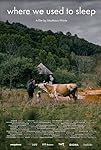Eye For Film >> Movies >> Where We Used To Sleep (2024) Film Review
Where We Used To Sleep
Reviewed by: Amber Wilkinson

Valeria Praţa is facing a change she does not want. A life-long resident of Romania’s rural Apuseni Mountains, her home is now threatened by flooding from a poisonous lake created by a local copper mine. The sickly mud and water have already claimed much of her village, including the church where her grandparents are buried. Now as the lake draws closer to her front door, Valeria must gradually come to terms with, potentially, having to leave her beloved cow Păuna behind and moving to the city with her dog Duracell to live with her son. As she succinctly puts it: “It hurts my soul.”
Becoming invisible is an observational documentarian’s most essential trick and one that Matthäus Wörle and his cinematographer Moritz Dehler achieve with the apparent ease of David Copperfield in Wörle's debut feature. What’s all the more admirable is the way he marries this to a more interrogative approach as interviews conducted with Valeria at a separate time are carefully applied as voice-over while we watch her go about her daily life. This offers a depth of contrast, meaning we can both see and appreciate the life that Valeria leads and the threat she faces, while also learning directly the emotional impact this is having upon her. The lilting score from Giuliano Loli that also incorporates more traditional music from time to time is a snugly fitting accompaniment.

Beyond that, Wörle also impressively introduces historical context for the film, via propaganda videos from the Ceaușescu era that speak of the huge mine and its processing plant as a “heroic chapter” in the country’s history. Images of industrial prowess emphasise the huge scale of the operation - bringing home the enormity of its impact but also tacitly making us aware of what a huge employer it must be and its importance to the local economy.
Wörle avoids taking any sort of overt political viewpoint, instead keeping an intimate focus on how Valeria is affected. The deconstruction of a lifetime is brought sharply home by the fact that even her home will, as per tradition, be dismantled when she leaves it. Beyond Valeria, we also meet other members of her small community along the way. A gathering of friends, which feels like an echo of the village’s former, more vibrant existence, acts as a poignant reminder of what is being lost. Wörle maintains our intimacy with Valeria while also offering insight into the bigger picture, raising questions regarding our care of the environment and those who rely upon it without labouring the point.
Valeria, we learn, is no longer with us, but this film stands as a testimony to her experience and stoicism - and that of many like her, who live small but significant and vibrant lives that are not usually caught on camera.
Reviewed on: 26 Mar 2024
















